I’d like to take this introduction space to explain the title I chose for this series. But first, let me explain what it is about this game that I love so much: it’s the people who play it. Magic is a social game, beyond the simple fact that it takes at least two to play a game (unless you play, as I did when my childhood friends got tired of indulging me, two or three decks against each other at once by yourself (it was my fault, really, bringing a Ravager deck to a casual fight)). Some of my best Saturday afternoons growing up were spent with a few other guys circled around an ever-growing sprawl of cards.
Every game shop has its own little community, and there are plenty of online groups that function just as well. All I did last spring was hang out on my clan’s Skype channel, playing and watching and commenting along with some simply fantastic players.
Every time one player sits across from another, the moment they shake hands, it’s as if war were declared. This is not Bobby Fischer’s chess, however. The object is not “to crush the opponent’s mind.” The point is to have fun. And sometimes — often, in fact — the best man doesn’t win. You’ll notice I wrote “best man” (sorry, ladies, but I’m afraid I have to go with the majority here ^^;;), not “best player.” Technical skill is important, but if seven years of playing this game at a competitive level have taught me anything, it’s that nothing is more important than being polite. Without that, winning just doesn’t matter.
I’ll tell you what does matter: the handshake matters at the beginning of the match when it says “I recognize you as my equal,” just as much as when, at the end, it proclaims “nothing has changed.” “Good game” has nothing to do with whether the game was ‘good’ or not — though even I’m not above the occasional wry remark, I still say “GG” after every game. It means, “thank you.” I always wish my opponent luck, whether in the next round or in their next draft because I’m aware that of my victory or loss was to some extent due to chance.
A polite opponent will make even the most ridiculously poor draws bearable, if not downright pleasant; conversely, a game in which one’s deck runs like a well-oiled machine into the opponent’s solar plexus will seem an arduous chore because of having to block out his incessant, childish whining. Though the greater Magic community consists mostly of decent, mature individuals (another reason to love the game is that so many players continue through marriage and parenthood — and a few even manage to live balanced lives!), there will always be trolls. My advice to you: Don’t. Feed. The Trolls. No matter how wrong they are, and no matter how hilarious it would be to incite them, the only way to be truly better than the trolls is to ignore them. They don’t deserve your regard.
It’s an absolute pleasure when I come across a player who just wants to have fun playing cards. So I try my best to do the same for others. “Table Manners” isn’t just an extremely clever pun for one’s drafting habits. Being polite, being a decent person, matters to me, and that’s why I write beneath those words. They matter.
Well, that’s quite the curve. Unlike many (non-blue) decks in this format, this deck will prefer being on the play, as those early levelers are just a beating. I’m rather fond of Suffer the Past, but it ultimately can’t replace any card in the deck. The sole exception is Pathrazer, which, though admittedly expensive (even for Rise), is a legitimate win-condition, something I felt the deck needed. Other possible inclusions would be Goblin Tunneler, for its synergy with Bloodthrone Vampire, and Ancient Stirrings for fixing and digging for Eldrazis. Inquisition will likely come in against blue decks, where it will be most effective.
R1G1 – choose to play
Such a sweet hand, with two bombs and removal. There are even three lands! Still, this hand wants to draw two different sorts of land to be effective, and we can’t count on that. It hurts, but we mull.
Though far from good, this hand can play just about any card we’ll draw and is certainly better than a random five.
Unfortunately, our opponent plays a Venerated Teacher to put his Zulaport Enforcer beyond the range of our Wrap in Flames, and since we don’t draw enough creatures to fuel Vampire, we lose to the evasive 5/5 in short order.
SB – Inquisition will be quite good against his UB deck, as almost all his cards are vulnerable to it. Pathrazer is slower than I’d like, so it gets the boot.
R1G2 – again, we choose to play
This is a fine hand. If we can draw a land in the first three or four turns, the rest of the acceleration will take us all the way. The great part is, all that mana-boosting still leaves some decent green bodies to battle with.
We haven’t played a land yet. We obviously play Predator, but the question is, which land to leave untapped? The “safe” play is to leave a Mountain, as we can be fairly sure our opponent will attempt to level on his turn, and trading a Spawn token to Heat Ray his leveler is a fine deal indeed. The thing, though, is that we don’t really care about his having a 3/3, or a 5/5. We’ll be having a 12/14 soon enough, unless he can do something about it. Playing Inquisition now is better since it means he can’t surprise us with anything later, top-decks notwithstanding.
Boys and girls, this is why we look both ways before we smash some face.
As anticipated, he did have disruption. Things might have gone differently in an alternate universe, but in this reality we won with a 12/12 trampler.
SB – out with Essence Feed, as it’s one of the weaker cards. We add in Suffer the Past to deal with some of his recursion (he’d shown us Cadaver Imp and Mnemonic Wall), while still functioning as a Drain Life effect.
R1G3 – put on draw
Cutthroat is reason enough to keep this hand, but the possibility of an early Conscription (I recall something about trample and deathtouch . . .) make this quite good.
He does manage to kill the Cutthroat, but Conscription manages to kill him. 4th pick, people.
Our next opponent was the impetus for the introduction of this article, just a genuinely nice player, and a fan to boot. It so happens he (if you’re reading it, dear opponent, please correct me if I’m wrong!) grabbed both Keening Stones, playing them in a UR Control build. Unfortunately for him, the matchup favors me heavily, but (s)he’s rather up-beat about it.
R2G1 – we’re on the play
This is a clear keep. Even if we don’t hit a Mountain soon, the abundance of our mana will make Null Champ a game-winning threat in no time. But, how do we play it out? Do we play the Champ on Turn 2, or just level Treespeaker? In the latter case, we’ll have five mana to play and level Champ on Turn 3, but that’s when we really want to be swinging with a 4/2. Instead, the correct line of play is to cast Treespeaker on Turn 1, Null Champion on Turn 2 (swing for 1), then, on Turn 3, level both our creatures (first the Elf, then the Null).
We win the game with green things and Wrap in Flames, though our opponent puts up a good fight.
R2G2 – we’re put on the draw
This is a clear mulligan, as neither of our spells does very much on its own. I don’t mind keeping the occasional 5-lander, especially on the draw, but this won’t cut it.
Much, much better; the presence of Snake Umbra and a two-drop alone makes this viable. Ophidian FTW!
Sadly for us, he has the Regress for our Vampire, and we lose to an acute lack of Naturalize against his Keener.
R2G3 – choose to play
This is absolutely juicy, and all the more so on the play. It’s a keeper.
Unfortunately, our opponent kills both our levelers with a Staggershock, but he’s got nothing at all to follow it. Ondu Giant deals something like ten damage, all by itself. I’m pretty sure he’s got Lay Bare, so we play around it, just in case. When he (mostly) taps out for a Frostwind Invoker, we play the Beastbreaker we’ve been holding, level, and start swinging with a 6/6 the next turn.
Again, our opponent is graceful and good-humored, even after taking what a lot of players would call a cheap loss. I can’t stress how much this sort of thing means to me — it really makes the game worth playing.
R3G1 – we choose to play
I forgot to get the screenshot of this hand during the game, and of course MODO chooses that replay to throw away. =p
We keep a mediocre hand with two colors and an early creature (Null Champ, 2 Forest, Swamp, Conscription, Pathrazer, Sarkhan. I think). It’s mediocre because we don’t have much to follow up that Null Champ if he can deal with it. Unless he’s got an unusually fast start, though, we should be fine. Oh, and because of scouting, we know he’s playing the Defender deck. ![]()
Okay, we’re obviously in a great position here, as there are only a couple of red or green cards in the format that can help him deal with a single 5/5 dragon, and only Disaster Radius will clear away two. Still, it’s important to play as correctly as possible, even when it won’t make or break the game. So, let me ask you: which creature becomes a dragon? Conventional thinking is to improve the least important creature on our board. In this case, however, the least important isn’t the smallest. Upgrading the Nest Invader instead of the Spawn token gives us another Dragon token, as well as the opportunity to play Conscription if we draw a land next turn. And besides, the 2/2 isn’t invading through his 3/3 any time soon.
So I hear dragons win games. Rawr.
No boards for this guy. His deck is pretty slow, so Pathrazer will be just fine. Our only real concern is building up enough force to punch through, but either of our bombs accomplishes that nicely.
R3G2 – we’re put on the play
We keep a very land-heavy hand because the combo of Vampire and infinite tokens is really that good. True, Vampire is fragile for a short while, but I’m loath to mulligan on the play.
We proceed to draw many, many lands, and then . . .
SARKHAN THE MAD HAHAHAHAHAHAHAH MHUAAHAHAHAH
…sorry ^^;;
CONCLUSION
Alright, so this “archetype” thing clearly isn’t working out. I swear Levelers hasn’t been open for at least the last dozen drafts I’ve run. The truth is, I do cherry-pick these drafts; every week I’ll draft a handful of times, usually over the weekend, and hopefully at least one of them includes A) three rounds, B) a technically instructive draft, and C) at least a few interesting tactical decisions to showcase. There’s really no point in writing an article if there’s nothing to talk about. Some weeks are better than others, and while I’d really love to show you guys around all the different archetypes, I really haven’t had very many drafts that fit all three of those qualifications. This one does.
Some notes:
-Conscription is GOOD. As with any other creature enchantment, one needs to be wary of disruption, but a well-timed Eldrazi Conscription creates an incredible threat instantaneously (albeit at sorcery speed =p). Most of the answers to Eldrazi in the set only get played on their controller’s turn, so if they haven’t been saving that Vendetta, there’s +10 trample damage and -2 permanents getting thrown at their face out of nowhere. Let me put it this way: Ulamogs Crusher is good, right? Now add +5/+5, haste and trample. Yeah.
-So are dragons. The best card in the entire format is a 4/4 black flyer named Drana. Oh, and she also kills things, which makes her bigger while she’s at it. Besides being BFFs with Viscera, what makes her especially dangerous is that there are a grand total of two removal spells that kill her by themselves (yes, one could double Last Kiss, and Induce Despair requires an appropriately large creature), and both of them are red. So, while 5/5 dragon tokens are susceptible to the black removal that can’t touch Drana, a measly Flame Slash won’t shoot them down either. And Sarkhan is usually good for at least two (he can also “shrink” the occasional game-winning Eldrazi!).
-It’s a real pleasure playing against people who realize this is just a game, the point of which is to have fun, and that losing doesn’t have to get in the way of that.
This is all I’m looking for
BONUS ROUND
Remember that time, when I said that a draft needed to hit those three points to make a good article? Well, here’s one that didn’t. I think you’ll have some fun with it, regardless.

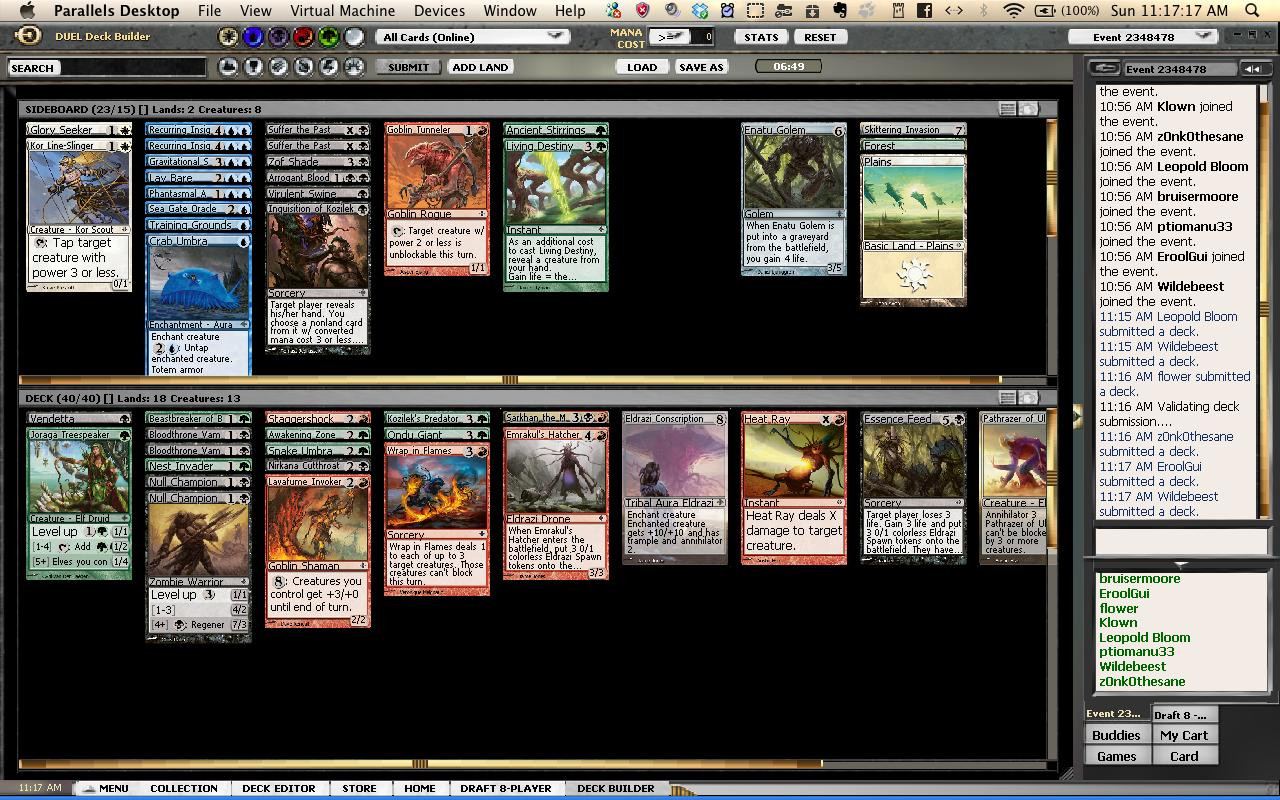



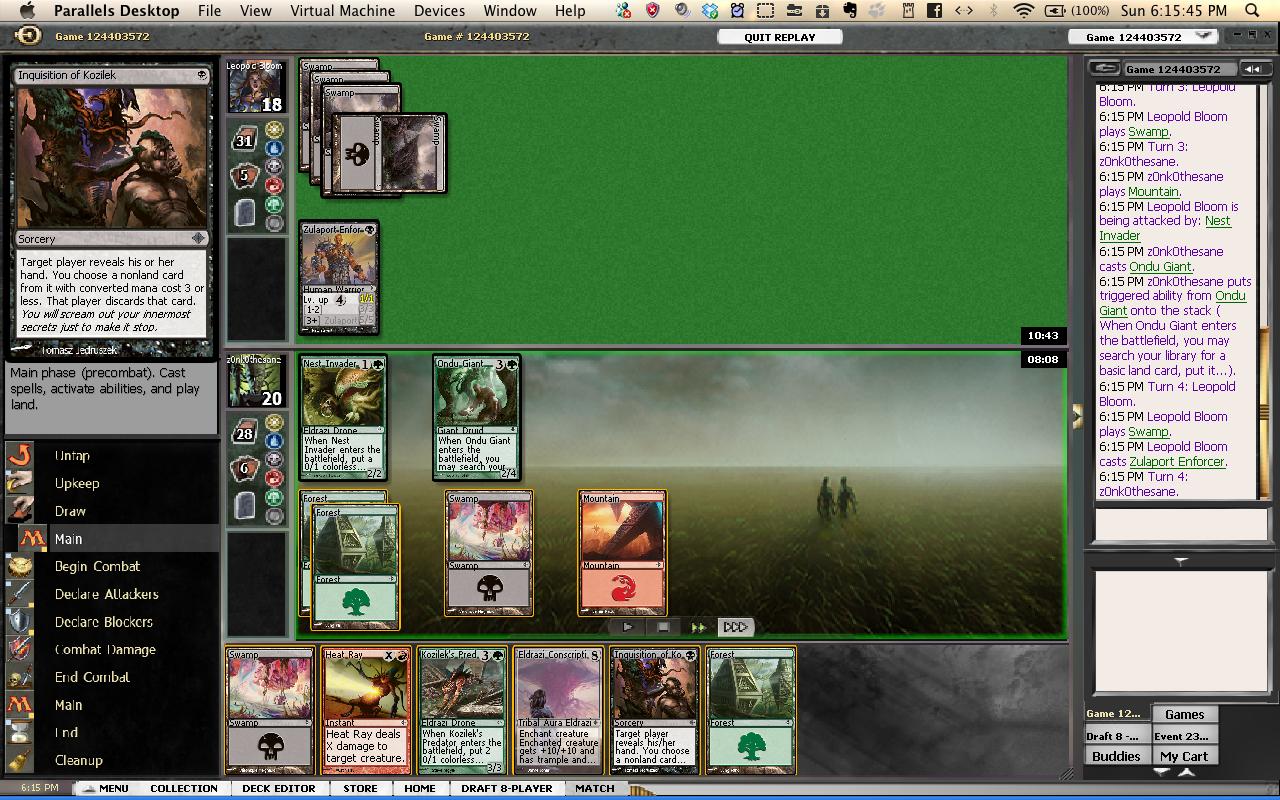
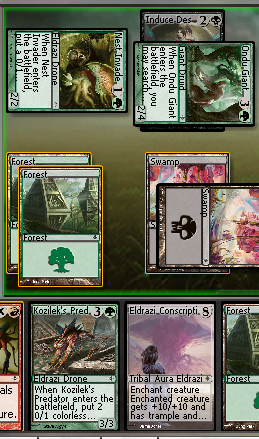





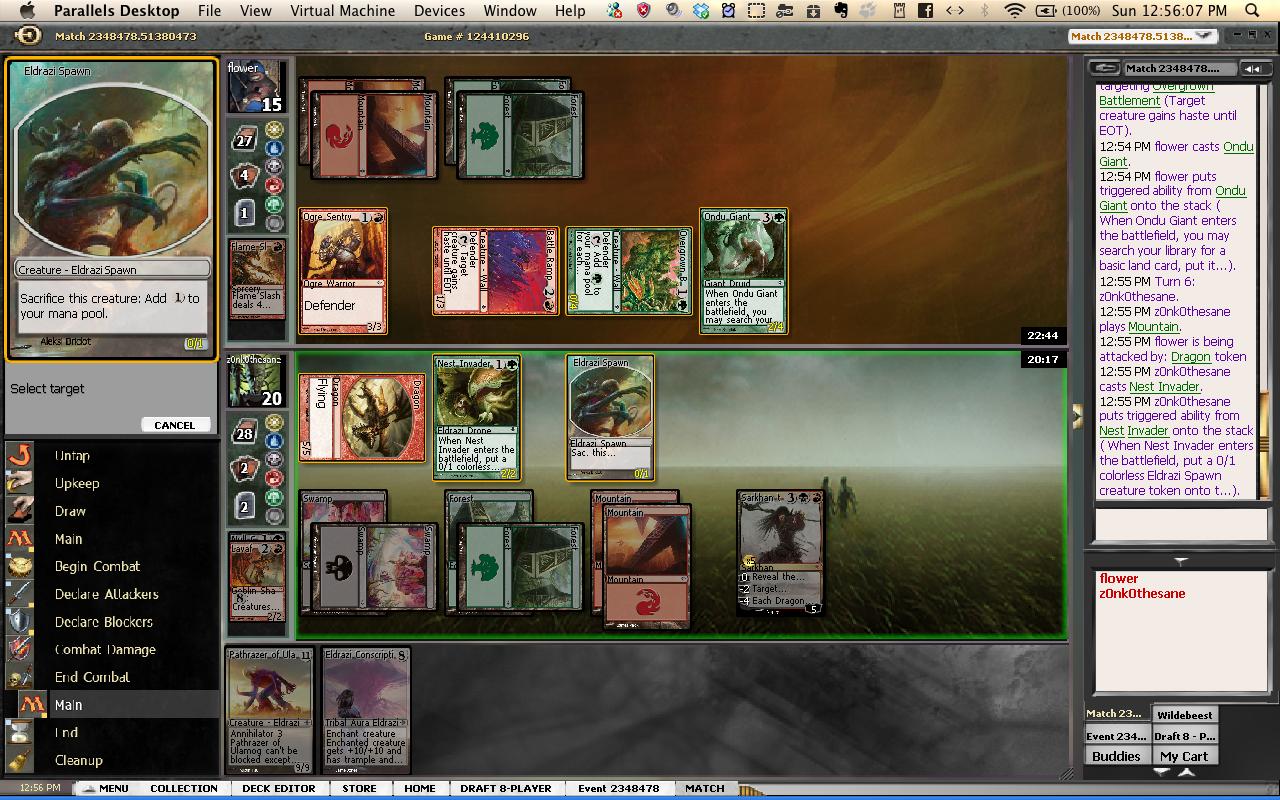

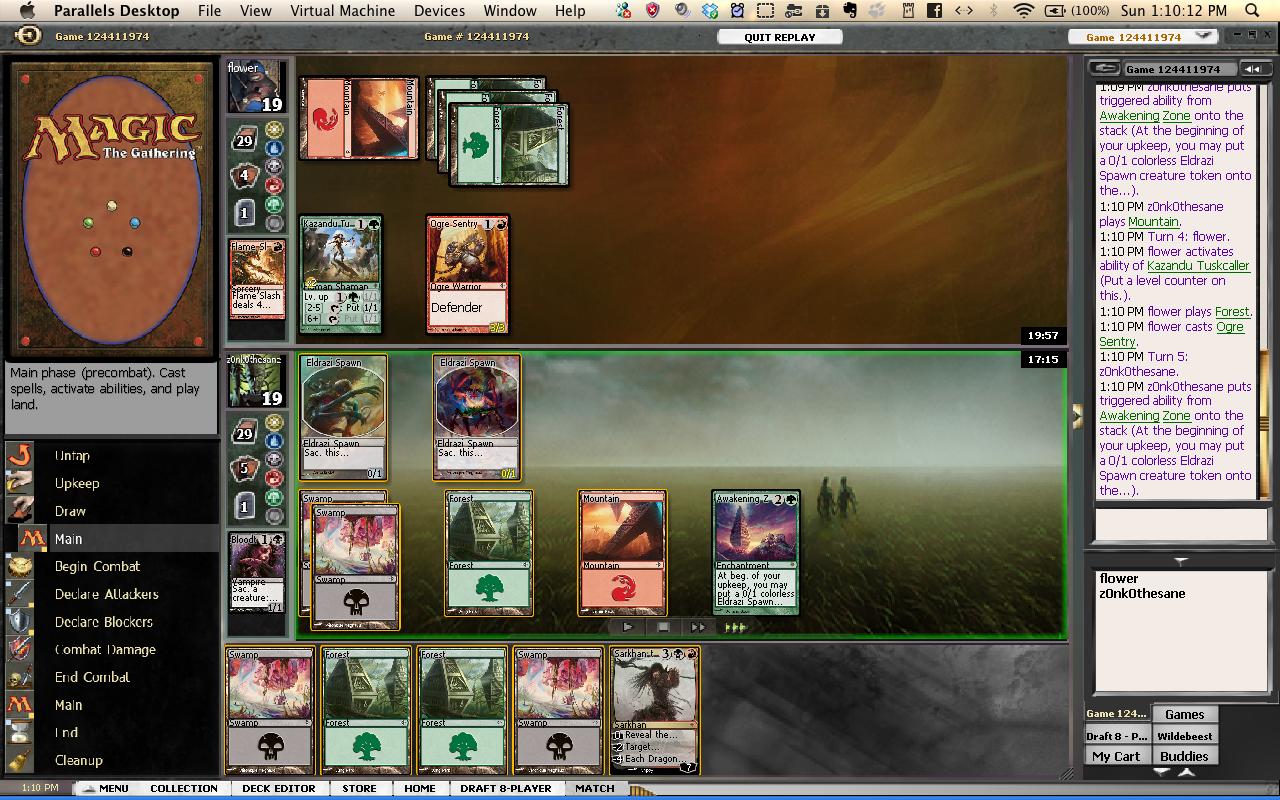

I have never drafted Rise of Eldrazi, so I read this article expecting to find out how to do it. But all I learnt was that it’s good to have some bombs. Did any of your opponents have bombs? You don’t mention anybody casting an Eldrazi (a big, colorless one I mean). Is it typical?
@miley:
For better or for worse, the stress of my articles is on the actual Draft. The rounds are much more for entertainment than education, though I try to present some situational analysis. Except for the mulligan decisions, I just don’t think the bulk of play requires elucidation. Some readers might feel differently (and please let me know if you do!), but when I read walk-throughs I always skim the bits where it says who hit which land drops. I hope the Draft portion was instructive?
Hmm . . . the guy in R2 had the Keening Stones, and I saw that Lord of Shatterskull Pass in R3′s replays . . .
It just so happens that none of my opponents were playing green, where the Eldrazi are most at home. I didn’t see a single one. However, almost every self-respecting green deck will play at least a couple.
I really enjoyed this, Zonko. I love ROE drafts in general and though I actually skipped the picks (seeing you open Sarkhan made me ragequit the draft portion :P), I looked at the eventual deck and enjoyed reading the strategies and ‘what happened’.
It wasn’t long, but exactly the right length for a piece like this I think. Just a nice article to read.
The mulligan decisions were informative and helpful, I’m quite greedy and it’s good for me to see strong mulligan decisions pay off =)
Oh and I liked the few ‘key plays’ you highlighted, good stuff imo!
@Zage:
I’m glad you liked it!
Mulliganing skillfully is *so* important. Honestly, more than half my losses come from greedy keeps.
I really do recommend the Draft commentary – I consider it the core of these articles; as for length, there’s usually a good 2,000 words hidden in the Raredraft box.
Thanks for the answer. It just seemed weird to start with Sarkhan and immediately add a third color, although I guess it’s acceptable in ROE, because you add more lands and more acceleration anyways. But I wanted the matches to convince me that it was the right decision, and they did not.
I’d like to read more about the matches, but it would mean much more work for you (which is fine for me of course :)). And I agree about the mulligans. I hate when somebody starts with: mulliganed to 5, I kept theese cards. These decisions definitely are important parts of the game.
Milegy,
In case you’d like to see an additional recent example of Rise draft, you can read Zonko’s previous article on Rise drafting here: http://www.mtgoacademy.com/table-manners-rise/
You can also watch Ryan and Marshall of Limited Resources draft ROE on video here, which is geared to be more instructional: http://www.mtgoacademy.com/limited-resources-a-pick-is-worth-a-thousand-words/
@miley
ROE is weird in that you can very easily splash a third color, sometimes a third and a fourth color, due to Evolving Wilds and Prophetic Prism at common, and Growth Spasm/Ondu Giant at common as well. So that’s 2 colorless sources that fix, and two green sources that fix an accelerate.
The one thing I don’t like about this draft is he plays Pathrazer of Ulamog, exactly the kind of card you want to avoid. Not only do cards like corpsehatch and vendetta kill it, but guard duty, narcolepsy, smite and regress are all commons that punish you for playing an 11 drop. ROE is essentially a race to 8 mana, for either Ulamog’s Crusher, or Wildheart/Dawnglare/Lavafume Invoker. There are so many amazing bombs at 8 mana, the only high end drops you want are Ulamog and Kozilek.
@drn:
Pathrazer deserves a little more respect than he gets. Attacking with the card yields an easy 6-for-1. Sure, he’s pricey, but few cards just break open a stalled board or topdeck war like he will, where Crusher just hits a few lands and gets chumped/double blocked. Almost any green deck will be able to hit 11 by the late game, and of the cards you list, only Corpsehatch and Narcolepsy really deal with him.
Mind you, I’m not saying he’s very good, and he was definitely the weakest card in my deck, but I wouldn’t call him bad, either.
Nope, he’s really just that bad. As I said, ROE is not only filled with cards that are excellent at shutting him down, but also clearing stalled boards, cards that should be taken highly. One attack with Ulamog’s Crusher also make it virtually impossible to get enough mana to play pathrazer, another reason the card is bad. Cards that are 3-4 turns slower than an invoker are almost unplayable even in dedicated ramp decks, and even then you only want the best of the best.
Also not a huge deal, but pack 4 you pick snake umbra over the aura gnarlid, which doesn’t make sense. Not only is aura gnarlid first pickable, but the deck that wants to play auras wants aura gnarlid more than anything else. He’s fine as a 2/2 with evasion, but with any decent equipment or aura he’s an awesome win condition. He also makes so many playable cards better (Guard Duty, Lust For War, Narcolepsy, Boar Umbra).
Also, and I don’t mean to overly criticize, I liked the article, but you have Sarkhan and Awakening Zone, a power mythic and rare, and yet play Pathrazer when you could have had 2-3 Lavafume Invoker. You even took Blodthrone Vampire over an invoker, which is an insanely bad pick (ignoring the blue card you took over the invoker for absolutely no reason). The only reason you would want to play bloodthrone over even your third invoker are for curve purposes, which rarely matters, and threaten effects.
You really don’t need to get to 11 mana to play a bad card when you can get to 8 and just win.
@drn: Now I’m with you with the Pathrazer being nearly unplayable, but I think Bloodthrone Vampire is *way* better than you give her credit for.
With a few Eldrazi Spawn out (and that’s not too hard this deck), she forces people into chump-block mode quickly or threatens a *ton* of damage, without costing you any mana. Sure she’s better with threatens, but I definitely disagree on getting 3 invokers before 1 bloodthrone vampire.
@drn:
I’m sorry, but I’d have to disagree about Gnarlid, except if one is forcing that deck. I wasn’t. Snake Umbra is great with any two-drop, but Gnarlid is just an Ogre without Auras, and I wasn’t about to commit my draft to building around one or two creatures.
Lavafume Invoker is one of the weaker Invokers because it’s a mediocre body with an effect that requires a specific board state. While Awakening Zone creates that state handily, my deck wasn’t dedicated to Tokens heavily enough for me to consider Lavafume very important. Notice the Invasion in the board.
@Zage When you have a board situation where bloodthrone would be good, Lavafume invoker is almost always better. You can also chump block bloodthrone all day, or bounce it for a huge blowout They both go into the same deck, but lavafume invoker is much better.
@Zonko
First, Lavafume invoker is one of the three “good” invokers, (Wildheart and Dawnglare are the only one’s better). You first picked a Sarkhan, and second picked an awakening zone, so immediately you should start drafting the tokens archetype, in which lavafume shines.
Gnarlid isn’t “just a grey ogre” he’s actually one of the only green creatures with evasion, which is what makes him so sweet. Auras are just an awesome way to get 2/1′d. Cards like Ogre’s Cleaver or pennon blade which go great in token decks put him way over the top.
Again, you might want to look at the flaws of your own draft to learn something. You take a late Suffer the Past as a “Pet Card” and pass a spawning breath, yet another card that would have been much, much better than that or Pathrazer in your tokens deck. Late cards like that make tokens deck insane, and spawning breath is great in a format with a million 1/1 levelers and cards like dawnglare invoker which require removal.
@drn: Now you’re just trolling, right?
Bloodthrone Vampire has the enormous advantage that she doesn’t require 8 (!!) mana to go to work. Without it being a good idea to sac spawn for Lavafume (they make his power better, after all), you need 8 lands to get him active, and then you need to hope they don’t have a few good blockers to decimate your army while a few spawn do some damage. Oh and you won’t have an army to block with after that.
Bloodthrone doesn’t sacrifice defense for offense, doesn’t require a million mana and turns into a one-person abyss later in the game. If they just chump with Spawn you don’t even need to sac anything.
There is no comparison, Bloodthrone Vampire is way better. (Normally I wouldn’t be so outspoken, but since you’re doing it I thought I’d go for some over-the-top rhetoric, too.)
@ Zage:
My daddy can beat up your daddy.
@Zonko:
I was (mostly) on your side! :’(
Also my daddy would win *this* big!
Bloodthrone Vampires does 1 damage a turn unless you sacrifice a creature, or they have a decent blocker, and leads to 2-1, 3-1, sometimes even 5 or 6-1′s due to bounce/removal.
Lavafume never gets you 2-1′d, and makes it very easy to overwhelm them and just win with what is on the board.
ROE as a format is generally a race to 8 mana. Bloodthrone Vampire is a mediocre, very situational card. Lavafume Invoker is a grey ogre that turns into a win condition when you ramp up.
If I can’t convince you, fine, but anyone who has drafted a lot of Rise should know which is better. The set had a ton of poorly evaluated cards like Battle-Rattle Shaman, various invokers and cards like ondu giant that routinely went later than they should.
If I can’t convince you, fine, but *anyone* that’s *ever* played *any* magic *at all* knows Bloodthrone Vampire is *always* better than Lavafume Invoker, in *any* situation.
Boy I see why you stick with this over the top rhetoric posting style form, it’s pretty fun
Also I reject your straw man argument about Battle-Rattle, various invokers and cards like Ondu Giant
Now I think I’ve had my fun though, so I’ll let you have the last jab if you want it and if it’s not too over the top, I’ll let it go :p